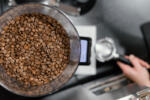Just think about how over 400 million coffee cups are ingested daily in America. Think about all those wasted grounds when we can use them to our advantage.
Should I put coffee grounds in my garden?
Adding fresh, uncomposted coffee to gardens at volume application rates of 2.5 percent or above is likely to impair overall plant growth and development.

Consequently, adding coffee grounds to your compost is probably a better option to allow for the breakdown of toxic components and the benefits of increased water holding capacity to emerge. It is recommended that coffee grinds account for no more than 20% of the volume of your compost.
If you have a patch that has been fallow for 6 months or more and want to limit the pace of weed formation, mixing freshly used coffee grinds into the soil or spreading a thin layer of mulch is a great alternative!
How coffee can help
Acid-loving plants, such as azaleas, camellias, gardenias, hibiscus, hydrangea, magnolias, and rhododendrons, thrive when coffee grounds are added to their soil. And FYI, coffee grounds contain copper, calcium, and magnesium; therefore, the soil of your other plants will also benefit from this method.
Who would’ve thought that you could use coffee as a part of your beauty regimen? Or that it can be used as a deodorizer or plant fertilizer? With so many different uses, it’s hard to list them all.
It’s like the gift that keeps on giving… and maybe now you’ll think twice before you throw those used coffee grounds into the trash.
The Facts
- Coffee grounds have an N-P-K composition of roughly 2.0-0.2-0.3. They increase the availability of P and K and release N as they decompose.
- They also contain calcium, magnesium, and copper.
- They have a carbon to nitrogen ratio of about 20:1 and are many, like any green leafy material you’d add to your compost.
- Coffee grounds can reduce insect infestation.
- They are slightly acidic and therefore are one of the best natural acid-loving plant fertilizers. They suit acid-loving plants like azalea, camelia, gardenia, hibiscus, hydrangea, magnolia, and rhododendron.
- They can help improve soil structure.
As compost
At Vanderbilt University, one of the on-campus coffee shops called “Common Grounds” promotes the use of biodegradable products along with the other coffee place, “The Last Drop Coffee Shop,” in the Sarratt Student Center.
As fertilizer
Coffee grounds are rich in nitrogen and are acidic. In line with this, should you have highly acidic garden soil, you might want to use lime powder to decrease acid content. If not, you may throw the grounds around your plants before watering. You will enjoy watching the benefits in no time!
To speed up the process, dig the grounds into your soil. Make sure not to go overboard since excessively moist coffee grounds create a breeding ground for mold and fungus. You may mix five gallons of water and about ½ pounds of wet coffee grounds for your fast-acting fertilizer. Let it sit for a while, and then it will be ready.
Coffee grounds placed in clean and dry egg shells at the plant base can shoo insects away. Also, sprinkling coffee grounds around your garden can keep cats away.
Coffee grounds also provide great media to let mushrooms thrive. Just place a mushroom plug into the grounds in the base of a container until it’s full. Wait for a few days and watch the growth that will take place.
Coffee filters and tea bags also work well in any compost file because of their relatively short decomposition duration. Coffee in compost promotes nitrogen balance.
How To Use Coffee Grounds Fertilizer In Your Garden
Here are some commonly used methods:
- Add it to your compost
- Add it directly to the soil around your acid-loving flower plants
- Add about 250g to a bucket of water, let it come to ambient temperature, and use it as a simple liquid fertilizer
- Mix them with crushed eggshells and put them in a circle around the base of plants to keep pests away
- Mix them with potting soil
They should be composted.
The most environmentally friendly way to dispose of coffee grounds is to compost them. Add enough grinds to make up around 10 to 20% of the total compost volume. They may hinder beneficial microbes from digesting organic matter if they become higher.
Another approach is to mix 4 parts shredded leaves and 1 part coffee grounds (by weight). Some individuals still propose adding lime or wood ash into the compost to balance the acidity of the grounds. You can do it, but it isn’t necessary. If you want to give it a go, add 1 cup of lime or ash to 10 pounds of ground coffee.
Apply a small coating on top.
Using coffee grounds as heavy mulch is not smart because they clump, forming a barrier that stops air and water from flowing through. If you want to spread the grounds over the soil, start with a thin layer (half an inch, top) of organic matter, followed by a thicker layer (2-4 inches), such as shredded bark, wood chips, or compost.
Adjust the pH of the soil.
If you want to acidify the notoriously alkaline soils west of the Mississippi, you must first do a soil test to ascertain the pH of your soil. If acidification is required, dig the grinds into the soil to a depth of 7 to 8 inches.
Consequently, adding coffee grounds to your compost is probably a better option to allow for the breakdown of toxic components and the benefits of increased water holding capacity to emerge. It is recommended that coffee grinds account for no more than 20% of the volume of your compost.
If you have a patch that has been fallow for 6 months or more and want to limit the pace of weed formation, mixing freshly used coffee grinds into the soil or spreading a thin layer of mulch is a great alternative!
Which plants like used coffee grounds?
Coffee grounds are slightly acidic, and unbrewed fresh coffee grounds have more acid. Your acid-loving plants like hydrangeas, rhododendrons, azaleas, lily of the valley, blueberries, carrots, and radishes can get a boost from fresh grounds.
However. in most cases, the fresh grounds are too acidic to be used directly on the soil, even for the acid-loving plants we mentioned above. Coffee grounds inhibit some plants’ growth, including geranium, asparagus fern, Chinese mustard, and Italian ryegrass.
Can you put too many coffee grounds in your garden?
So apply a limited amount of coffee grounds. We recommend a layer no thicker than half an inch. Working coffee grounds into the soil will improve its tilth, but do this sparingly.
Please comment below with any other success you’ve had using them, and we’ll add your ideas to the list.

Editorial Staff
The editorial staff at Crazy Coffee Crave is a team of coffee enthusiasts & Baristas who enjoy the one thing we all think about as soon as we get up in the morning. Trusted by thousands of readers worldwide.






